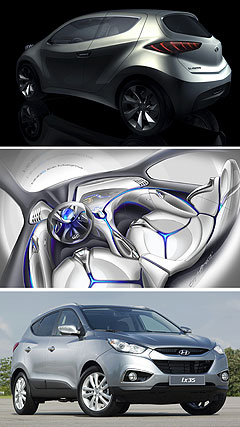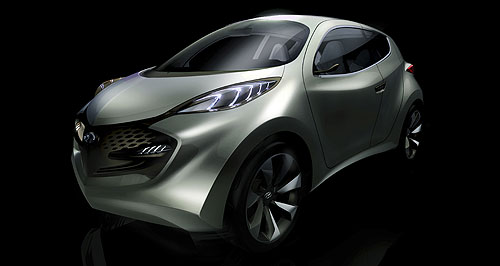Make / Model Search
Future models - Hyundai - ix-MetroFirst look: Hyundai’s all-new baby hybrid SUVBaby SUV: Hyundai will spring the hybrid ix-Metro - one size smaller than the Tucson-replacing ix35 - at Frankfurt. Hyundai unveils sub-ix35 compact SUV concept and production all-electric i107 Sep 2009 By TERRY MARTIN HYUNDAI has revealed the first images and details of an all-new petrol-electric sub-ix35 compact SUV and a full-electric version of its i10 ultra-light car ahead of their world premiere at the Frankfurt motor show next week. Confirming Frankfurt’s status as the greenest motor show ever staged – or bluest, to borrow the colour most of the world’s car-makers are using to describe their new eco cars – the South Korean auto giant will use the event to preview the design direction for a forthcoming ‘compact utility vehicle’ (CUV), dubbed the ix-Metro, and to introduce the production version of its first EV, the i10 Electric, which will hit the streets of Seoul in the second half of 2010. Both vehicles come under a new ‘Blue Drive’ environmental sub-brand – a less controversial branding exercise than the ‘EcoDynamics’ label its sister brand Kia will launch in Frankfurt – with the ix-Metro demonstrating some important technologies (including a new petrol-electric drivetrain and dual-clutch gearbox), and the i10 Electric emerging as a vital new member of Hyundai’s expanding low-emissions stable.  From top: The Hyundai hybrid ix-Metro, Hyundai ix-Metro interior, Hyundai ix35. From top: The Hyundai hybrid ix-Metro, Hyundai ix-Metro interior, Hyundai ix35.Aiming to become one of the top-four global manufacturers of low-emissions vehicles by 2012, Hyundai-Kia is embarking on an international rollout of its LPG-electric hybrid drivetrain for the Elantra/Cerato – both of which are under consideration for Australia – and last month announced it would launch its first fuel-cell-powered EV in South Korea within three years. This is the same timeframe it has set for mass-production of the i10 Electric, which will be leased in limited numbers during 2010, but, according to European product planning manager Hans-Ulrich Goebel¸ the prohibitive costs of batteries will limit mainstream sales and export to countries outside South Korea. “The cost is €10,000 ($A16,830) for batteries alone in the car you see here,” he said. “We believe there will be a big market (for the i10 Electric), but the European market is not there yet.” Relying on a 49kW electric motor and 16kW/h lithium-ion polymer battery, the 1000kg EV is claimed to offer a 160km driving range, 15-second 0-100km/h acceleration and a 130km/h top speed. Full recharging can be achieved within five hours using a 220-volt household outlet, with industrial-strength 413-volt current enabling an 85 per cent recharge in less than 15 minutes. Meanwhile, the ix-Metro’s powertrain combines a small 5kW integrated starter motor/alternator (drawing power from an electric double-layer capacitor and 12-volt battery) with a 1.0-litre 12-valve DOHC CVVT three-cylinder turbocharged ‘GDI’ direct-injection petrol engine. The result is 92kW of power at 6000rpm and 157Nm of torque from 1750-4500rpm. The powertrain drives the front wheels through an all-new six-speed dual-clutch transmission and, according to the manufacturer, emits just 80g/km of CO2. The lightweight (950kg) ix-Metro rests on a 2513mm wheelbase and measures 3925mm long, 1760mm wide and 1576mm high. It has a ground clearance of 207mm. Designed at Hyundai’s Namyang design centre in South Korea, the ix-Metro is said to explore a new direction with its use of faceted surfaces and strong triangulating lines, which aim to achieve a “pleasing dynamic tension”. There is also a high beltline designed to give the occupants a more cosseting, protective feeling. The designers have dispensed with a B-pillar on the ix-Metro, but have adopted a sliding mechanism for rear access rather than conventional ‘suicide doors’. The show car has 2+2 seating and 20-inch wheels with 245/40-section tyres, digital side-view cameras, ice-blue LED interior lighting, and practical elements such as foldable rear seats and cargo area “which are connected into one functional loading area”. Other cabin features include a wraparound effect to the cockpit design, which connects the dashboard, centre console, door panel and front seats with a unified look. Surfaces for the seating, cargo area and other panels are divided using light-filled gaps. The dashboard is also covered in a white semi-transparent silicon-like material, to create a hi-tech feel. “We wanted the ix-Metro to be something out of this world,” said chief designer Rogelio Flores. “We took our inspiration from NASA and even sci-fi movies because spacecraft are universally understood symbols of progress and innovation.” European design chief Thomas Buerkle said the concept was completed just in time for the Frankfurt show. “It will arrive in Frankfurt just in time. The paint is almost wet when you see it first,” he said. Hyundai will also use the Frankfurt motor show to present, for the first time in Europe, the Australian-bound all-new ix35 compact SUV (replacing the Tucson) – the first interior photographs of which were released last week – and the facelifted Santa Fe medium-sized SUV. The Elantra LPI (LPG) Hybrid will also be there, along with a Europe-only ‘Blue’ edition of the i30, which adds idle-stop technology to a 1.6-litre turbo-diesel engine. Hyundai Motor Co Australia (HMCA) has also welcomed news this week that increased production of the i20 in Europe should free-up Hyundai’s plant in Chennai, India, which will be the source for Australia-bound models. “The expanded capacity is a result of the i20’s success in Europe,” said HMCA sales and marketing director Kevin McCann. “This should free-up assembly lines for Australian-specification cars and will enable us to move closer to confirming launch plans for Australia.”  Read more1st of September 2009  Fresh Santa Fe images emergeMore images of Hyundai’s facelifted Santa Fe emerge ahead of Frankfurt debut1st of September 2009  Hyundai confirms ix35 SUV for OzAll-new compact SUV from Hyundai will be known as the ix35 in Australia too10th of August 2009  Kia commits to fuel cell EV by 2012Fuel cell and plug-in EVs to join petrol and diesel hybrids from Hyundai-Kia24th of July 2009  Hyundai minis lost in translationShadow on Indian-built Hyundai i10 and i20 over shipping, currencyAll future models Alfa Romeo Alfa Romeo Abarth Abarth Alpine Alpine Alpina Alpina Audi Audi Aston Martin Aston Martin BMW BMW Bentley Bentley Chery Chery Brabham Brabham Chrysler Chrysler Chevrolet Chevrolet Cupra Cupra Citroen Citroen DS DS Dodge Dodge Fiat Fiat Ferrari Ferrari Foton Foton Ford Ford Great Wall Great Wall FPV FPV Haval Haval GWM GWM Honda Honda Holden Holden Hummer Hummer HSV HSV Infiniti Infiniti Hyundai Hyundai Jaguar Jaguar Isuzu Isuzu Kia Kia Jeep Jeep Land Rover Land Rover Lamborghini Lamborghini Lexus Lexus LDV LDV Mahindra Mahindra Lotus Lotus Mazda Mazda Maserati Maserati Mercedes-AMG Mercedes-AMG McLaren McLaren MG MG Mercedes-Benz Mercedes-Benz Mitsubishi Mitsubishi Mini Mini Opel Opel Nissan Nissan Peugeot Peugeot Pagani Pagani Proton Proton Porsche Porsche Renault Renault Ram Ram Rover Rover Rolls-Royce Rolls-Royce Skoda Skoda Saab Saab SsangYong SsangYong Smart Smart Suzuki Suzuki Subaru Subaru Toyota Toyota Tesla Tesla Volvo VolvoMotor industry news |
Click to shareHyundai modelsResearch Hyundai All future models Alfa Romeo Alfa Romeo Abarth Abarth Alpine Alpine Alpina Alpina Audi Audi Aston Martin Aston Martin BMW BMW Bentley Bentley Chery Chery Brabham Brabham Chrysler Chrysler Chevrolet Chevrolet Cupra Cupra Citroen Citroen DS DS Dodge Dodge Fiat Fiat Ferrari Ferrari Foton Foton Ford Ford Great Wall Great Wall FPV FPV Haval Haval GWM GWM Honda Honda Holden Holden Hummer Hummer HSV HSV Infiniti Infiniti Hyundai Hyundai Jaguar Jaguar Isuzu Isuzu Kia Kia Jeep Jeep Land Rover Land Rover Lamborghini Lamborghini Lexus Lexus LDV LDV Mahindra Mahindra Lotus Lotus Mazda Mazda Maserati Maserati Mercedes-AMG Mercedes-AMG McLaren McLaren MG MG Mercedes-Benz Mercedes-Benz Mitsubishi Mitsubishi Mini Mini Opel Opel Nissan Nissan Peugeot Peugeot Pagani Pagani Proton Proton Porsche Porsche Renault Renault Ram Ram Rover Rover Rolls-Royce Rolls-Royce Skoda Skoda Saab Saab SsangYong SsangYong Smart Smart Suzuki Suzuki Subaru Subaru Toyota Toyota Tesla Tesla Volvo VolvoMotor industry news |










Facebook Twitter Instagram